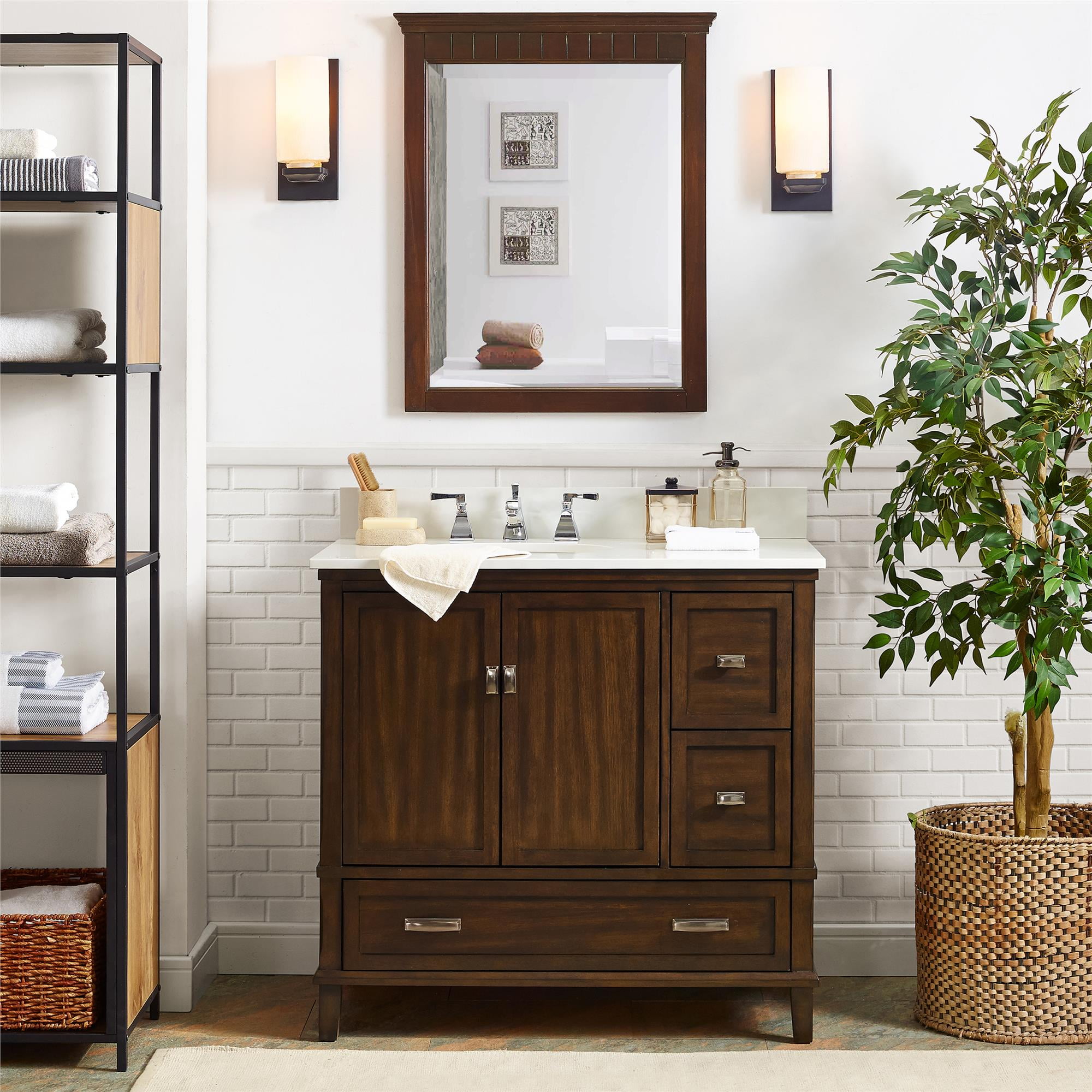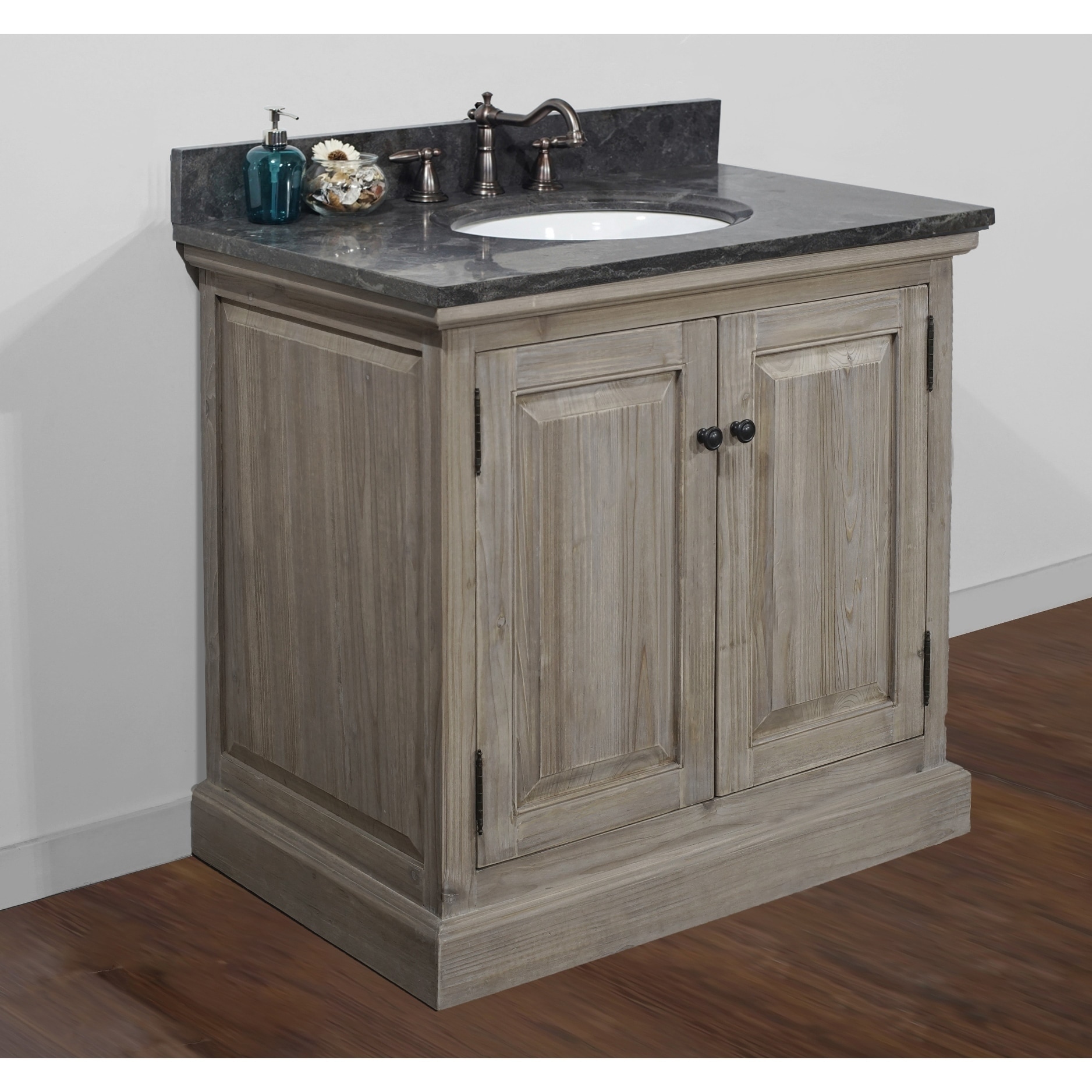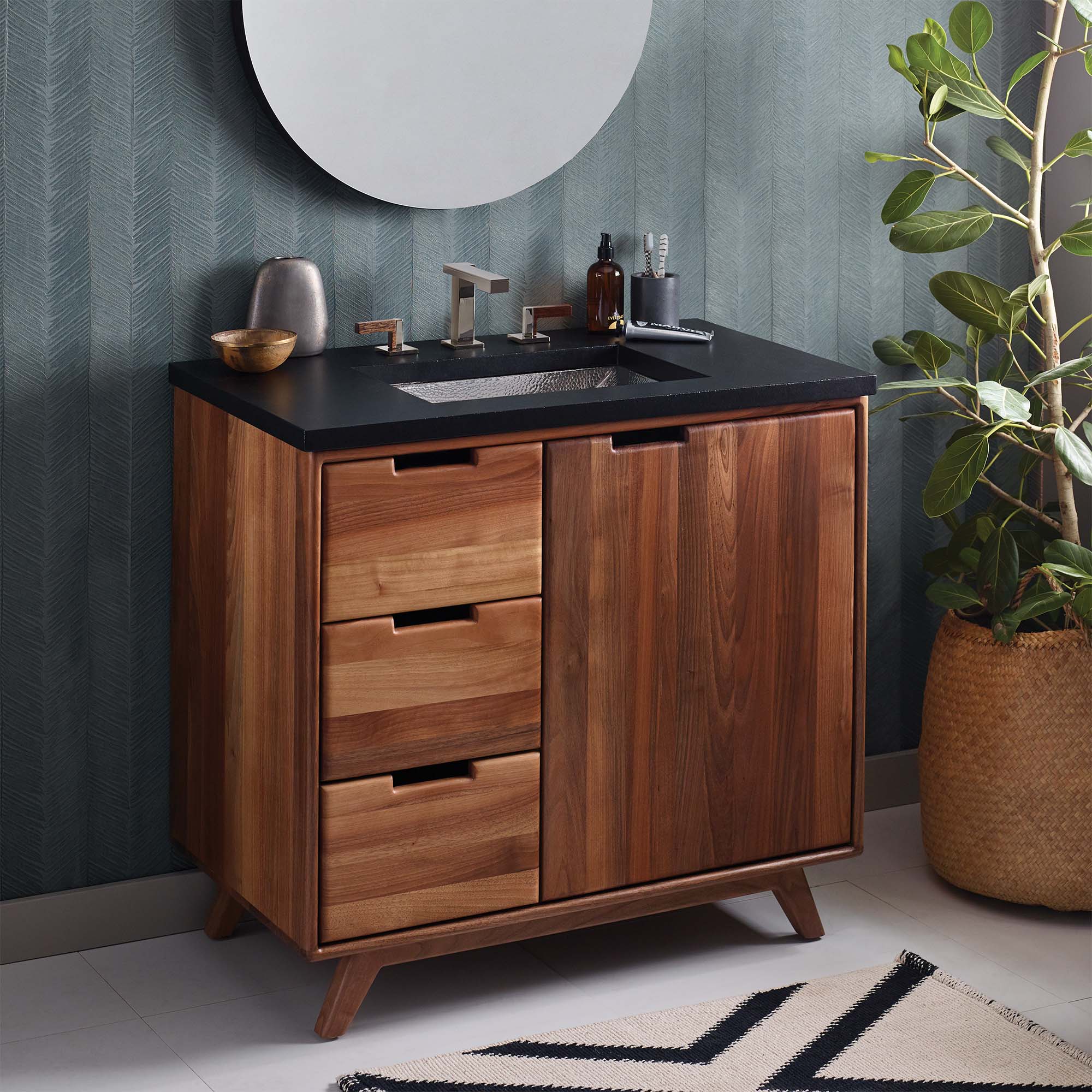Choosing the Right 36 Inch Vanity: 36 Inch Height Bathroom Vanity

A 36-inch vanity is a popular choice for bathrooms of all sizes, offering a balance between functionality and space efficiency. It’s a versatile option that can work well in smaller bathrooms where space is at a premium, and it can also be a stylish and practical choice for larger bathrooms.
Pros and Cons of a 36 Inch Vanity
A 36-inch vanity provides a good amount of counter space and storage, but it’s important to weigh the pros and cons before making a decision.
- Pros:
- Good Counter Space: A 36-inch vanity offers ample counter space for everyday bathroom essentials, such as toiletries, makeup, and hair styling tools.
- Adequate Storage: It typically comes with drawers and cabinets, providing sufficient storage for towels, linens, and other bathroom necessities.
- Space Efficiency: A 36-inch vanity is a good choice for smaller bathrooms, as it doesn’t take up too much floor space.
- Versatility: It can be used in a variety of bathroom styles, from traditional to modern.
- Cons:
- Limited Storage: Compared to larger vanities, a 36-inch vanity may have less storage space, which can be a challenge for those with extensive bathroom needs.
- Potentially Small Sink: A 36-inch vanity might accommodate a smaller sink, which could be less convenient for washing hands or brushing teeth.
Factors to Consider When Choosing a 36 Inch Vanity
There are several factors to consider when choosing a 36-inch vanity, including:
- Bathroom Size: Measure your bathroom carefully to ensure a 36-inch vanity will fit comfortably without overcrowding the space.
- Storage Needs: Evaluate your storage needs. If you have a lot of bathroom essentials, you may need to consider a vanity with more drawers and cabinets.
- Style Preferences: Choose a vanity that complements the overall style of your bathroom. Consider the materials, finishes, and design elements.
- Budget: Set a realistic budget for your vanity, and be sure to factor in the cost of installation.
Materials for 36 Inch Vanities
Vanities are available in a variety of materials, each with its own advantages and disadvantages:
- Wood:
- Pros: Durable, beautiful, can be customized with different finishes.
- Cons: More expensive than other materials, susceptible to moisture damage if not properly sealed.
- Laminate:
- Pros: Affordable, moisture-resistant, easy to clean.
- Cons: Less durable than wood, can be susceptible to scratches and dents.
- Stone:
- Pros: Elegant, durable, resistant to moisture and scratches.
- Cons: Expensive, heavy, requires professional installation.
Bathroom Layout with a 36 Inch Vanity
Here’s a sample bathroom layout incorporating a 36-inch vanity:
Layout:
- Vanity: Place the 36-inch vanity against a wall, leaving ample space for movement around it.
- Toilet: Position the toilet to the side of the vanity, maintaining a comfortable distance between them.
- Shower: If you have a shower, position it opposite the vanity, creating a balanced layout.
- Storage: Consider adding a linen closet or shelves for additional storage.
- Lighting: Install adequate lighting above the vanity and in other areas of the bathroom.
Features and Functionality of 36 Inch Vanities

A 36-inch bathroom vanity is a popular choice for smaller bathrooms or powder rooms, offering a balance of functionality and space efficiency. Beyond its size, a 36-inch vanity offers a variety of features and functionalities to enhance the overall bathroom experience.
Types of Sinks
The sink is a crucial component of any vanity, and 36-inch vanities come with a range of sink options.
- Vessel Sinks: These stylish sinks sit atop the countertop, creating a unique visual appeal. Vessel sinks often come in a variety of materials, including ceramic, glass, and stone. They offer a more modern and minimalist look, but they can be less practical for everyday use. Since the basin sits above the countertop, splashing is more likely to occur, and the counter space can feel smaller.
- Undermount Sinks: These sinks are installed below the countertop, creating a seamless and modern look. Undermount sinks are easier to clean and offer more counter space. However, they can be more expensive to install than other sink types. They are also not as versatile in terms of style.
- Drop-in Sinks: These sinks are the most common type of sink and are simply dropped into a cutout in the countertop. Drop-in sinks are the most affordable and offer a wide range of styles and materials. They are easy to install, but they may not be as aesthetically pleasing as other options.
Storage Capacity
A 36-inch vanity provides ample storage space for bathroom essentials, but the specific storage capacity can vary depending on the design. Here’s a comparison of the storage capacity of different 36-inch vanity designs:
| Vanity Design | Drawers | Shelves | Cabinet Compartments |
|---|---|---|---|
| Single-door cabinet with drawers | 2-3 | 0 | 1 |
| Double-door cabinet with drawers | 2-4 | 0 | 2 |
| Double-door cabinet with shelves | 0-1 | 2-4 | 2 |
Hardware
Choosing the right hardware for your 36-inch vanity is important for both functionality and aesthetics.
- Style: The style of your hardware should complement the overall design of your bathroom. For example, modern bathrooms may benefit from sleek, minimalist hardware, while traditional bathrooms may prefer ornate hardware. Consider the style of your faucets, towel bars, and other bathroom accessories to ensure a cohesive look.
- Durability: Bathroom hardware is exposed to moisture and frequent use, so durability is crucial. Consider hardware made from materials like stainless steel, brass, or nickel, which are resistant to corrosion and wear. Avoid hardware with delicate finishes that can easily scratch or chip.
- Ease of Maintenance: Choose hardware that is easy to clean and maintain. Hardware with simple designs and smooth surfaces is generally easier to clean than hardware with intricate details. Consider the type of finish, as some finishes may require more frequent cleaning than others.
Installation and Maintenance of 36 Inch Vanities

Installing a 36-inch vanity is a relatively straightforward process that can be accomplished with basic DIY skills and the right tools. It involves connecting plumbing, electrical, and countertop elements to ensure the vanity functions correctly. Regular maintenance is essential to preserve its appearance and functionality, extending its lifespan and ensuring its optimal performance.
Installing a 36 Inch Vanity
The installation of a 36-inch vanity involves a series of steps, starting with preparation and ending with final adjustments.
- Prepare the area: Ensure the bathroom floor is level and clear of obstructions. Disconnect the water supply to the old vanity and remove the existing unit.
- Install the vanity base: Position the vanity base in the desired location and secure it to the floor using the provided mounting hardware.
- Connect the plumbing: Attach the drain pipe to the vanity’s drain outlet and connect the water supply lines to the faucet’s inlets. Ensure all connections are secure and leak-free.
- Install the countertop: Place the countertop on the vanity base and secure it using the provided clamps or screws. Align the countertop to ensure it sits flush with the base and the sink is centered.
- Connect the faucet: Install the faucet on the countertop and connect the water supply lines. Test the faucet for leaks and proper functionality.
- Connect the electrical: If the vanity includes a mirror with lighting, connect the electrical wiring to the mirror’s light fixture. Ensure the wiring is properly grounded and meets electrical codes.
- Final adjustments: Once all connections are made, inspect the vanity for any leaks, loose connections, or misalignments. Make necessary adjustments to ensure everything is secure and functions correctly.
Maintaining a 36 Inch Vanity
Maintaining a 36-inch vanity involves regular cleaning and periodic inspections to ensure its functionality and appearance remain optimal.
- Clean the vanity regularly: Wipe down the vanity surface, countertop, and sink with a damp cloth and mild cleaner. Avoid using harsh chemicals or abrasive cleaners that can damage the finish.
- Clean the faucet and hardware: Wipe down the faucet and hardware with a damp cloth and mild cleaner. Regularly clean the faucet aerator to prevent mineral buildup and ensure smooth water flow.
- Inspect the drain: Check the vanity drain for any clogs or blockages. Clean the drain regularly to prevent clogs and ensure proper water drainage.
- Inspect the countertop: Check the countertop for any cracks or damage. Repair any damage promptly to prevent further deterioration.
- Inspect the base: Check the vanity base for any signs of water damage or warping. Address any issues promptly to prevent further deterioration.
Common Problems and Solutions, 36 inch height bathroom vanity
A few common problems can arise with 36-inch vanities, but most are easily addressed with basic maintenance and repair.
- Leaking faucets: Replace the faucet cartridge or repair the faucet’s internal mechanism.
- Clogged drains: Use a plunger or drain snake to clear the clog. Regularly clean the drain to prevent future clogs.
- Loose hardware: Tighten loose screws or bolts. Replace any damaged hardware.
- Water damage: Repair any water damage promptly to prevent further deterioration. Consider using a sealant to protect the vanity from future water damage.
- Countertop cracks: Repair small cracks with epoxy resin. For larger cracks, consider replacing the countertop.
Tools and Materials for Basic Repairs
Having a basic set of tools and materials readily available can help you address common problems and maintain your 36-inch vanity.
- Screwdriver: For tightening loose screws and bolts.
- Plunger: For clearing clogged drains.
- Drain snake: For clearing stubborn clogs.
- Wrench: For tightening plumbing connections.
- Adjustable wrench: For tightening plumbing connections of various sizes.
- Silicone sealant: For sealing cracks and gaps.
- Epoxy resin: For repairing countertop cracks.
- Cleaning supplies: For cleaning the vanity, countertop, and hardware.
